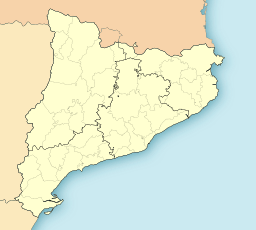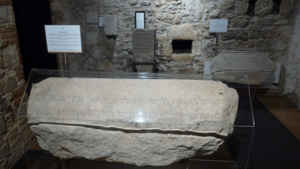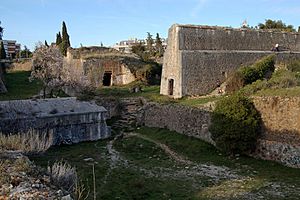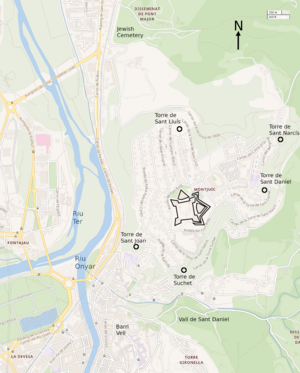Montjuïc (Girona) facts for kids
Quick facts for kids Montjuïc |
|
|---|---|
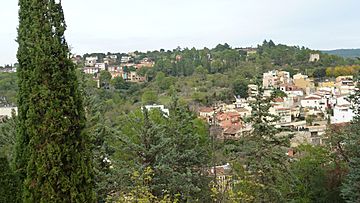
The neighborhood of Montjuic in 2019 as viewed from Girona Cathedral. The Suchet Tower (1812) is at upper right, while Montjuic Castle (1653) is mostly hidden by trees and residential buildings
|
|
| Highest point | |
| Geography | |
Montjuïc is a hill located in the ancient city of Girona, Spain. It sits just north of the city's old quarter. This area is where the Onyar, Galligants, and Ter rivers meet. Today, "Montjuïc" also refers to the neighborhood and district on the hill. The name comes from old Catalan and means "mountain of the Jews." The hill stands 219 meters tall.
For much of Girona's history, Montjuïc was not lived on. It was home to the city's medieval Jewish cemetery. It also had the Montjuïc Castle, a defensive fort built in the 1600s. Girona's Montjuïc is much like the more famous Montjuïc in Barcelona. Both are large hills next to a city. Both have a big castle fortress from the mid-1600s. And both have an old Jewish cemetery.
Contents
The Jewish Cemetery of Montjuïc
By the 1100s, Girona had a thriving Jewish community. It was home to one of Europe's most important Kabbalistic schools. Jewish people could not be buried in Christian cemeteries. So, Girona's leaders created a special burial place for them. This cemetery was outside the city walls but very close.
The Jewish cemetery was on the western side of Montjuïc. It was owned by the Spanish crown. The first mention of the cemetery is around the year 1200. Funeral processions would travel from the Jewish quarter of Girona to the graveyard. They followed a specific route.
In 1492, all Jews were forced to leave Spain. This happened because of the Alhambra Decree. On July 14, 1492, the Jewish community gave the cemetery to a nobleman. His name was Joan de Sarriera. They did this to thank him for his help. In the years that followed, the cemetery's gravestones were taken. These were often large, shaped rocks with Hebrew writing. They were used to build things around Girona. Some of these gravestones have been found again. You can see them at the Museum of Jewish History in Girona.
The cemetery was forgotten for a long time. It was rediscovered in 1862. This happened when a railway line was being built. The railway path went between the Ter river and Montjuïc's western slope. Workers found 20 tombstones with Hebrew writing. The cemetery was damaged even more in the 1960s. Today, there are no clear signs that the Jewish cemetery was ever there.
The cemetery was bordered by two small Montjuïc creeks. The southern creek is called Bou d'Or. This area is east of the Pont Major neighborhood. It is also near the railroad line. It is northwest of the Montjuïc neighborhood.
Montjuïc Castle: A Fortress for Girona
Montjuïc Castle sits at the top of Montjuïc hill. It was built to protect the city of Girona. King Philip IV of Spain ordered its construction. Building began in 1653. The castle had a main fort and four defensive towers. These towers were about 500 meters away from the main fort. They were named Sant Joan, Sant Daniel, Sant Narcís, and Sant Luís.
The main fort was square-shaped. It had four strong corner sections called bastions. The walls between these sections were about 150 meters long. An extra defensive tower was built in 1812. It was named after its builder, the French Marshal Louis-Gabriel Suchet.
Montjuïc Castle was used a lot during the Peninsular War. This war was between Spain and France from 1808 to 1814. The castle was destroyed and taken by the French in August 1809. This happened during the 7-month-long Third siege of Girona. Marshal Suchet ordered the castle to be left empty in 1814. In 1843, during a Catalan revolt called "Jamància," the castle was destroyed. General Juan Prim ordered it to be hit with artillery.
Montjuïc in the 1900s
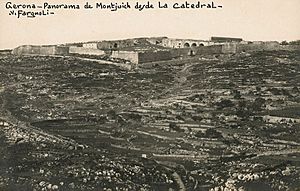
At the start of the 1900s, the area around the castle was undeveloped. In the 1930s, Girona's City Council planned to build on the mountain. They wanted to create a school and a garden city for working-class families. However, the Spanish Civil War (1936-1939) stopped these plans. Later, under the Franco city councils, the project was abandoned. The mountain was declared a green zone in 1955. But the city council could not get the land from the castle. It was still military property.
Between 1950 and 1970, many people moved to Girona. They came from other parts of Spain, like Andalusia and Extremadura. They were looking for better jobs. Many built their own homes around the Castle. This created a shanty town. By the late 1960s, almost 3000 people had settled on the hill.
In 1966, Ferran de Vilallonga bought the land. He made plans for building on it. From 1967 to 1971, the squatters were moved to other Girona neighborhoods. A new suburb was built on Montjuïc. This area was for middle- to upper-class residents. Eventually, houses covered the whole mountain. They surrounded the castle ruins. In 1986, 1381 people lived in Montjuïc.
See also
 In Spanish: Montjuic (Gerona) para niños
In Spanish: Montjuic (Gerona) para niños


